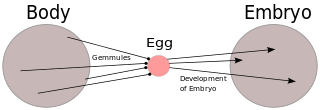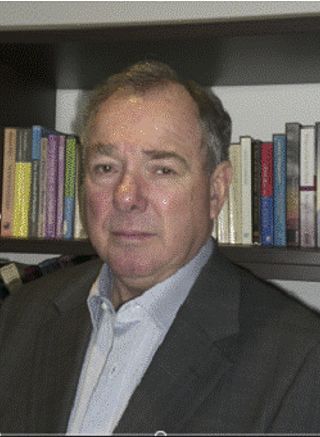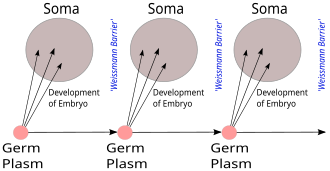
Genetics is the study of genes, genetic variation, and heredity in organisms. It is an important branch in biology because heredity is vital to organisms' evolution. Gregor Mendel, a Moravian Augustinian friar working in the 19th century in Brno, was the first to study genetics scientifically. Mendel studied "trait inheritance", patterns in the way traits are handed down from parents to offspring over time. He observed that organisms inherit traits by way of discrete "units of inheritance". This term, still used today, is a somewhat ambiguous definition of what is referred to as a gene.

Heredity, also called inheritance or biological inheritance, is the passing on of traits from parents to their offspring; either through asexual reproduction or sexual reproduction, the offspring cells or organisms acquire the genetic information of their parents. Through heredity, variations between individuals can accumulate and cause species to evolve by natural selection. The study of heredity in biology is genetics.

Pangenesis was Charles Darwin's hypothetical mechanism for heredity, in which he proposed that each part of the body continually emitted its own type of small organic particles called gemmules that aggregated in the gonads, contributing heritable information to the gametes. He presented this 'provisional hypothesis' in his 1868 work The Variation of Animals and Plants Under Domestication, intending it to fill what he perceived as a major gap in evolutionary theory at the time. The etymology of the word comes from the Greek words pan and genesis ("birth") or genos ("origin"). Pangenesis mirrored ideas originally formulated by Hippocrates and other pre-Darwinian scientists, but using new concepts such as cell theory, explaining cell development as beginning with gemmules which were specified to be necessary for the occurrence of new growths in an organism, both in initial development and regeneration. It also accounted for regeneration and the Lamarckian concept of the inheritance of acquired characteristics, as a body part altered by the environment would produce altered gemmules. This made Pangenesis popular among the neo-Lamarckian school of evolutionary thought. This hypothesis was made effectively obsolete after the 1900 rediscovery among biologists of Gregor Mendel's theory of the particulate nature of inheritance.

Neo-Darwinism is generally used to describe any integration of Charles Darwin's theory of evolution by natural selection with Gregor Mendel's theory of genetics. It mostly refers to evolutionary theory from either 1895 or 1942, but it can mean any new Darwinian- and Mendelian-based theory, such as the current evolutionary theory.

August Friedrich Leopold Weismann FRS (For), HonFRSE, LLD was a German evolutionary biologist. Fellow German Ernst Mayr ranked him as the second most notable evolutionary theorist of the 19th century, after Charles Darwin. Weismann became the Director of the Zoological Institute and the first Professor of Zoology at Freiburg.
Biological determinism, also known as genetic determinism, is the belief that human behaviour is directly controlled by an individual's genes or some component of their physiology, generally at the expense of the role of the environment, whether in embryonic development or in learning. Genetic reductionism is a similar concept, but it is distinct from genetic determinism in that the former refers to the level of understanding, while the latter refers to the supposed causal role of genes. Biological determinism has been associated with movements in science and society including eugenics, scientific racism, and the debates around the heritability of IQ, the basis of sexual orientation, and evolutionary foundations of cooperation in sociobiology.
The central dogma of molecular biology deals with the flow of genetic information within a biological system. It is often stated as "DNA makes RNA, and RNA makes protein", although this is not its original meaning. It was first stated by Francis Crick in 1957, then published in 1958:
The Central Dogma. This states that once "information" has passed into protein it cannot get out again. In more detail, the transfer of information from nucleic acid to nucleic acid, or from nucleic acid to protein may be possible, but transfer from protein to protein, or from protein to nucleic acid is impossible. Information here means the precise determination of sequence, either of bases in the nucleic acid or of amino acid residues in the protein.

The modern synthesis was the early 20th-century synthesis of Charles Darwin's theory of evolution and Gregor Mendel's ideas on heredity into a joint mathematical framework. Julian Huxley coined the term in his 1942 book, Evolution: The Modern Synthesis. The synthesis combined the ideas of natural selection, Mendelian genetics, and population genetics. It also related the broad-scale macroevolution seen by palaeontologists to the small-scale microevolution of local populations.

Lamarckism, also known as Lamarckian inheritance or neo-Lamarckism, is the notion that an organism can pass on to its offspring physical characteristics that the parent organism acquired through use or disuse during its lifetime. It is also called the inheritance of acquired characteristics or more recently soft inheritance. The idea is named after the French zoologist Jean-Baptiste Lamarck (1744–1829), who incorporated the classical era theory of soft inheritance into his theory of evolution as a supplement to his concept of orthogenesis, a drive towards complexity.
In cellular biology, a somatic cell, or vegetal cell, is any biological cell forming the body of a multicellular organism other than a gamete, germ cell, gametocyte or undifferentiated stem cell. Somatic cells compose the body of an organism and divide through mitosis.
In cellular biology, the term somatic is derived from the French somatique which comes from Ancient Greek σωματικός, and σῶμα is often used to refer to the cells of the body, in contrast to the reproductive (germline) cells, which usually give rise to the egg or sperm. These somatic cells are diploid, containing two copies of each chromosome, whereas germ cells are haploid, as they only contain one copy of each chromosome. Although under normal circumstances all somatic cells in an organism contain identical DNA, they develop a variety of tissue-specific characteristics. This process is called differentiation, through epigenetic and regulatory alterations. The grouping of similar cells and tissues creates the foundation for organs.

Genetic variation is the difference in DNA among individuals or the differences between populations among the same species. The multiple sources of genetic variation include mutation and genetic recombination. Mutations are the ultimate sources of genetic variation, but other mechanisms, such as genetic drift, contribute to it, as well.

In biology and genetics, the germline is the population of a multicellular organism's cells that develop into germ cells. In other words, they are the cells that form gametes, which can come together to form a zygote. They differentiate in the gonads from primordial germ cells into gametogonia, which develop into gametocytes, which develop into the final gametes. This process is known as gametogenesis.

The Weismann barrier, proposed by August Weismann, is the strict distinction between the "immortal" germ cell lineages producing gametes and "disposable" somatic cells in animals, in contrast to Charles Darwin's proposed pangenesis mechanism for inheritance.

Blending inheritance is an obsolete theory in biology from the 19th century. The theory is that the progeny inherits any characteristic as the average of the parents' values of that characteristic. As an example of this, a crossing of a red flower variety with a white variety of the same species would yield pink-flowered offspring.

The history of genetics dates from the classical era with contributions by Pythagoras, Hippocrates, Aristotle, Epicurus, and others. Modern genetics began with the work of the Augustinian friar Gregor Johann Mendel. His works on pea plants, published in 1866, provided the initial evidence that, on its rediscovery in 1900's, helped to establish the theory of Mendelian inheritance.

Edward J. "Ted" Steele is an Australian molecular immunologist with interests in virology and evolution. He is an honorary research associate at the C.Y.O'Connor ERADE Village Foundation in Piara Waters, WA, Australia.
This article considers the history of zoology since the theory of evolution by natural selection proposed by Charles Darwin in 1859.

Transgenerational epigenetic inheritance is the transmission of epigenetic markers and modifications from one generation to multiple subsequent generations without altering the primary structure of DNA. Thus, the regulation of genes via epigenetic mechanisms can be heritable; the amount of transcripts and proteins produced can be altered by inherited epigenetic changes. In order for epigenetic marks to be heritable, however, they must occur in the gametes in animals, but since plants lack a definitive germline and can propagate, epigenetic marks in any tissue can be heritable.
Germ-Soma Differentiation is the process by which organisms develop distinct germline and somatic cells. The development of cell differentiation has been one of the critical aspects of the evolution of multicellularity and sexual reproduction in organisms. Multicellularity has evolved upwards of 25 times, and due to this there is great possibility that multiple factors have shaped the differentiation of cells. There are three general types of cells: germ cells, somatic cells, and stem cells. Germ cells lead to the production of gametes, while somatic cells perform all other functions within the body. Within the broad category of somatic cells, there is further specialization as cells become specified to certain tissues and functions. In addition, stem cell are undifferentiated cells which can develop into a specialized cell and are the earliest type of cell in a cell lineage. Due to the differentiation in function, somatic cells are found only in multicellular organisms, as in unicellular ones the purposes of somatic and germ cells are consolidated in one cell.













